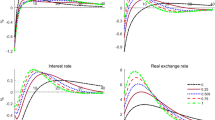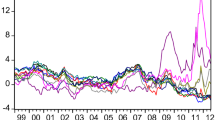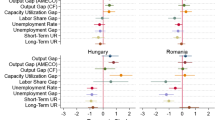Abstract
Theoretical exposition and empirical evidence in central bank independence (CBI) literature confirm an inverse relationship between inflation and measures of CBI mostly in developed economies. Based on this ex ante information on CBI-inflation tradeoff, this paper proposes two functional forms for the diagonal and off diagonal elements in the residual covariance matrix in the estimation process. The proposed functional forms are used in a generalized maximum likelihood and then in a generalized least squares (GLS) (with the restricted covariance matrix) framework for the empirical test. The results are compared to the outcome of an SUR model (unrestricted). The tests involve 14 emerging economies and covers the period 1960–1990. Compared to SUR, majority of results of GLS model in samples with and without outliers provide stronger and more significant evidence confirming the CBI-inflation tradeoff. Notably, the standard errors of the GLS estimates are lower than that of the SUR estimates. Without outliers, the GLS estimates show even lower standard errors as compared to the outcome of the SUR model. Low standard errors provide baseline indication of more accurate estimates.
Similar content being viewed by others
References
Alesina A., Summers L. (1993). Central bank independence and macroeconomic performance. Journal of Money, Credit and Banking 25:157–162
Alesina A., Tabelinni G. (1987). Rules and discretion with non-coordinated monetary and fiscal policy. Economic Enquiry 25:619–630
Backus D., Driffill J. (1985). Inflation and reputation. American Economic Review 75:530–538
Bade, R. and Parkin, M. (1985), Central bank laws and monetary policy. Unpublished Manuscript, University of Western Ontario, Canada
Banaian, K. and Willett, T. (1983), ‚Central bank independence: an international comparison’, Economic Review, Federal Reserve Bank of Dallas, 1–13
Barro R., Gordon D. (1983). A positive theory of monetary policy in a natural rate model. Journal of Political Economy 91:589–610
Bekaert G., Campbell C.R. (2002). Research in emerging markets finance: looking to the future. Emerging Markets Review 3:429–448
Cukierman, A. (1992), Central Bank Strategy and Independence: Theory and Evidence, MIT Press
Cukierman A., Kalatzidakis P., Summers L., Webb S. (1993). Central bank independence, growth, investment and real rates. Carnegie – Rochester Conference Series on Public Policy 39:95–140
Cukierman A., Webb S., Neyapti B. (1992). Measuring the independence of central banks and its effect on policy outcomes. The World Bank Economic Review 6:353–398
Debelle, G. and Fischer, S. (1994), ‚How independent should a central bank be?’, Center for Economic Policy Research, Stanford University, Discussion Paper
Diana G., Sidiropoulos M. (2004). Central bank independence, speed of disinflation and sacrifice ratio. Open Economies Review 15:385–402
Dolmas J., Huffman G., Wynne M. (2000). Inequality, inflation and central bank independence. Canadian Journal of Economics 33:271–287
Down I. (2004). Central bank independence, disinflations and sacrifice ratio. Comparative Political Studies 37:399–434
Eijffinger, S. and De Haan, J. (1996), The political economy of central bank independence. Special Papers in International Economics, Princeton University, 19
Grilli, V., Masciandaro, D. and Tabelinni, G. (1991), ‚Political and monetary institutions and public financial policies in industrial countries’, Economic Policy 6, 342–392
IFC (1997) Emerging Stock Markets Factbook 1997. International Financial Corporation, Washington, DC
Kydland, F. and Prescott, E. (1977), ‘Rules rather than discretion: The inconsistency of optimal plans,’ Journal of Political Economy 85, 473–490
Lohmann S. (1992). Optimal commitment in monetary policy versus flexibility. American Economic Review 82:273–286
Neyapti B. (2003). Budget deficits and inflation: the roles of central bank independence and financial market development. Contemporary Economic Policy 21:458–475
Schellekens P. (2002). Caution and conservatism in making of monetary policy. Journal of Money, Credit and Banking 34:160–177
Siklos P. (2004). Central bank behavior, the institutional framework, and policy regimes: inflation versus non-inflation targeting countries. Contemporary Economic Policy 22:331–343
Sintim-Aboagye, H. and Tufte, D. (2006), `Central bank independence, inflation variability and revenue smoothing hypothesis', International Advances in Economic Research 12(2), 147–160
Spiegel, M. (1998), ‚Central bank independence and inflation expectations: evidence from British index-linked gilts’, Economic Review, Federal Reserve Bank of San Francisco, 3–20
Author information
Authors and Affiliations
Corresponding author
Additional information
This research has benefited from comments from David Tufte, and Gerald Whitney and contributions by participants at the colloquia series at the Montclair State University and the University of New Orleans.
Rights and permissions
About this article
Cite this article
Sintim-Aboagye, H. Emerging Economies, Turnover Rates and Inflation Variability: A Comparison of Generalized Maximum Likelihood and SUR Models. Econ Change 38, 167–178 (2005). https://doi.org/10.1007/s10644-006-9001-1
Received:
Accepted:
Published:
Issue Date:
DOI: https://doi.org/10.1007/s10644-006-9001-1




